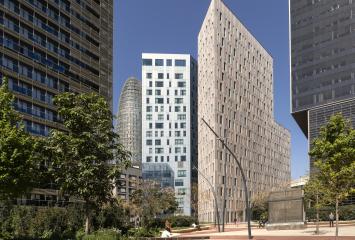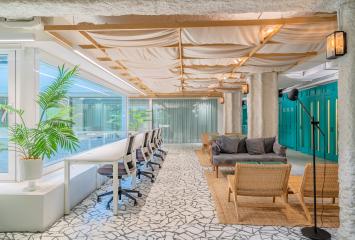Urban heat island: how green roofs help mitigate this phenomenon
Rapid population growth and climate change are causing an increase in exposure to extreme heat in cities. This phenomenon is known as "heat island" and is becoming more and more recurrent, causing the heat of the summer season to worsen. Heat islands cause an increase in temperature, especially at night, a fact that is more accentuated in the center of cities compared to surrounding areas, such as suburbs or rural areas.
There are several causes that contribute to its formation, among them, the materials used to build infrastructure, such as asphalt, concrete, or cement, which absorb more energy and disperse it little by little in the form of heat. Added to all this is the lack of vegetation that absorbs light and generates humidity in urban spaces.
High temperatures negatively affect not only the environment, as there is an increase in energy demand for air conditioning and increased air pollution, but also the quality of life and the health of citizens.
Is it possible to mitigate the effects?
There are several measures that can be taken to reverse the effect of the heat island in large metropolises, such as, for example, increasing green spaces, areas of water or shade, using white paint or creating green roofs.
The latter in particular take advantage of the cooling of vegetation to lower the temperature and are an artificial system that is installed on the roofs of buildings, which are covered with plants. Any green roof shares the same characteristics, which includes waterproofing and root repellent to keep the structure safe and prevent damage from occurring.
What are the benefits?
Green roofs provide numerous economic and environmental benefits:
- energy savings thanks to insulation: a flat roof, without vegetation, can accumulate up to 21º C more heat than a green roof. Thanks to the covers, the need to use air conditioning in summer and heating in winter is reduced.
- lower ambient temperature and CO₂ absorption thanks to plants.
- cleaner air, since vegetation captures the fine particles suspended in the air that constitute one of the greatest dangers for public health. It is estimated that an extensive vegetation cover captures 1.5 kilos of fine particles per hectare, which is roughly equivalent to the capacity of a mature tree. Therefore, with 10% or 20% of green roofs in the city, the health of its inhabitants would be significantly improved.
- they promote biodiversity: they are an important refuge for birds and insects in urban areas.
- rainwater retention: less burden on sewage and sanitation.
- rainwater purification.
Green roofs also work as noise insulators, since they allow a reduction in noise reflection of 3dB and acoustic insulation of up to 8dB, also providing numerous benefits for people's health, including, for example, that their natural appearance invites relaxation and reduction of stress level.
The green roof of the Discovery Building
At Colonial, one of our goals is to help mitigate the effects of climate change and promote sustainable development.
That is why we have implemented green roofs in some of our buildings: in the case of our Discovery Building, we have carried out a thermography on the green roof and through the images we have been able to demonstrate how the presence of vegetation reduces the heat island, also reducing climatic needs of the top floor of the building.
In short, we can affirm that the implementation of green roofs is a real, effective, and relatively easy-to-implement strategy that can be adopted by cities to combat the effects of climate change at all levels.

